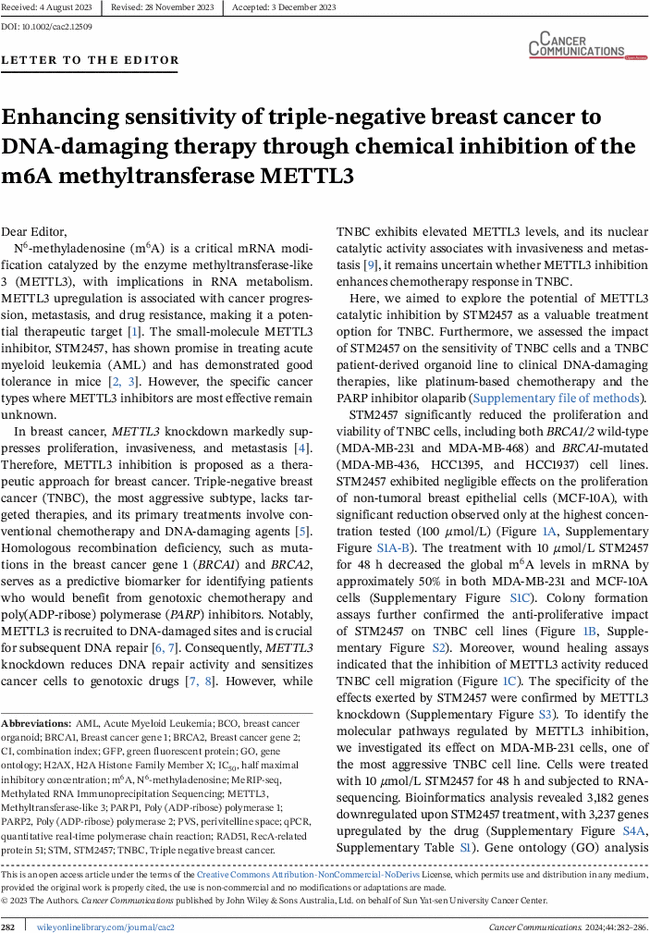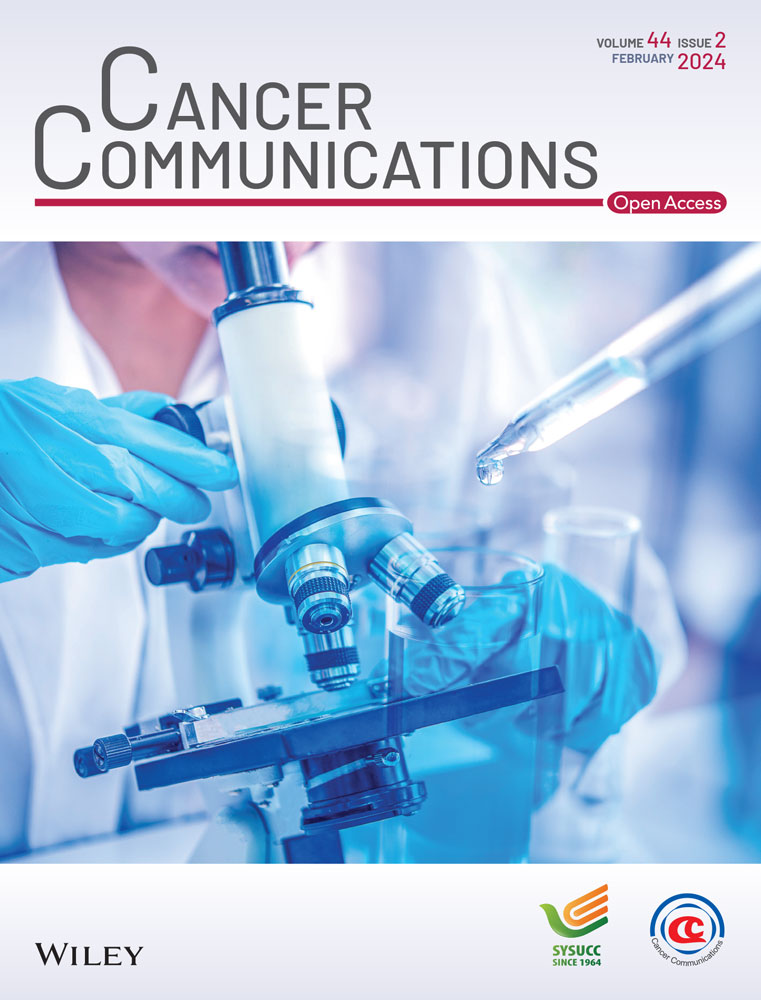Enhancing sensitivity of triple-negative breast cancer to DNA-damaging therapy through chemical inhibition of the m6A methyltransferase METTL3
Bianca Cesaro
Department of Anatomical, Histological, Forensic & Orthopedic Sciences, Section of Histology & Medical Embryology, Sapienza University of Rome, Rome, Italy
Search for more papers by this authorAlessia Iaiza
Department of Biology and Biotechnologies “Charles Darwin”, Sapienza University of Rome, Rome, Italy
Search for more papers by this authorFabio Piscopo
Department of Biology and Biotechnologies “Charles Darwin”, Sapienza University of Rome, Rome, Italy
Search for more papers by this authorMarco Tarullo
Department of Biology and Biotechnologies “Charles Darwin”, Sapienza University of Rome, Rome, Italy
Search for more papers by this authorEleonora Cesari
GSTeP Organoids Research Core Facility, Fondazione Policlinico A. Gemelli Istituto di Ricovero e Cura a Carattere Scientifico (IRCCS), Rome, Italy
Search for more papers by this authorDante Rotili
Department of Drug Chemistry and Technologies, Sapienza University of Rome, Rome, Italy
Search for more papers by this authorAntonello Mai
Department of Drug Chemistry and Technologies, Sapienza University of Rome, Rome, Italy
Pasteur Institute, Cenci-Bolognetti Foundation, Sapienza University of Rome, Rome, Italy
Search for more papers by this authorAlberto Diana
Department of BioSciences, University of Milan, Milan, Italy
Search for more papers by this authorMichela Londero
Department of BioSciences, University of Milan, Milan, Italy
Search for more papers by this authorLuca Del Giacco
Department of BioSciences, University of Milan, Milan, Italy
Search for more papers by this authorRiccardo Masetti
GSTeP Organoids Research Core Facility, Fondazione Policlinico A. Gemelli Istituto di Ricovero e Cura a Carattere Scientifico (IRCCS), Rome, Italy
Multidisciplinary Breast Center, Dipartimento Scienze della Salute della Donna e del Bambino e di Sanità Pubblica, Catholic University of the Sacred Heart, Rome, Italy
Search for more papers by this authorAlba Di Leone
GSTeP Organoids Research Core Facility, Fondazione Policlinico A. Gemelli Istituto di Ricovero e Cura a Carattere Scientifico (IRCCS), Rome, Italy
Multidisciplinary Breast Center, Dipartimento Scienze della Salute della Donna e del Bambino e di Sanità Pubblica, Catholic University of the Sacred Heart, Rome, Italy
Search for more papers by this authorChiara Naro
GSTeP Organoids Research Core Facility, Fondazione Policlinico A. Gemelli Istituto di Ricovero e Cura a Carattere Scientifico (IRCCS), Rome, Italy
Department of Neuroscience, Section of Human Anatomy, Catholic University of the Sacred Heart, Rome, Italy
Search for more papers by this authorSilvia Masciarelli
Department of Anatomical, Histological, Forensic & Orthopedic Sciences, Section of Histology & Medical Embryology, Sapienza University of Rome, Rome, Italy
Search for more papers by this authorGiulia Fontemaggi
Oncogenomic and Epigenetic Unit, IRCCS Regina Elena National Cancer Institute, Rome, Italy
Search for more papers by this authorClaudio Sette
GSTeP Organoids Research Core Facility, Fondazione Policlinico A. Gemelli Istituto di Ricovero e Cura a Carattere Scientifico (IRCCS), Rome, Italy
Department of Neuroscience, Section of Human Anatomy, Catholic University of the Sacred Heart, Rome, Italy
Search for more papers by this authorCorresponding Author
Francesco Fazi
Department of Anatomical, Histological, Forensic & Orthopedic Sciences, Section of Histology & Medical Embryology, Sapienza University of Rome, Rome, Italy
Pasteur Institute, Cenci-Bolognetti Foundation, Sapienza University of Rome, Rome, Italy
Correspondence
Alessandro Fatica, Department of Biology and Biotechnologies “Charles Darwin”, Sapienza University of Rome, P.le Aldo Moro 5, Rome 00185, Italy.
Email: [email protected]
Francesco Fazi, Department of Anatomical, Histological, Forensic & Orthopedic Sciences, Section of Histology & Medical Embryology, Sapienza University of Rome, Via Scarpa 16, Rome 00161, Italy.
Email: [email protected]
Search for more papers by this authorCorresponding Author
Alessandro Fatica
Department of Biology and Biotechnologies “Charles Darwin”, Sapienza University of Rome, Rome, Italy
Correspondence
Alessandro Fatica, Department of Biology and Biotechnologies “Charles Darwin”, Sapienza University of Rome, P.le Aldo Moro 5, Rome 00185, Italy.
Email: [email protected]
Francesco Fazi, Department of Anatomical, Histological, Forensic & Orthopedic Sciences, Section of Histology & Medical Embryology, Sapienza University of Rome, Via Scarpa 16, Rome 00161, Italy.
Email: [email protected]
Search for more papers by this authorBianca Cesaro
Department of Anatomical, Histological, Forensic & Orthopedic Sciences, Section of Histology & Medical Embryology, Sapienza University of Rome, Rome, Italy
Search for more papers by this authorAlessia Iaiza
Department of Biology and Biotechnologies “Charles Darwin”, Sapienza University of Rome, Rome, Italy
Search for more papers by this authorFabio Piscopo
Department of Biology and Biotechnologies “Charles Darwin”, Sapienza University of Rome, Rome, Italy
Search for more papers by this authorMarco Tarullo
Department of Biology and Biotechnologies “Charles Darwin”, Sapienza University of Rome, Rome, Italy
Search for more papers by this authorEleonora Cesari
GSTeP Organoids Research Core Facility, Fondazione Policlinico A. Gemelli Istituto di Ricovero e Cura a Carattere Scientifico (IRCCS), Rome, Italy
Search for more papers by this authorDante Rotili
Department of Drug Chemistry and Technologies, Sapienza University of Rome, Rome, Italy
Search for more papers by this authorAntonello Mai
Department of Drug Chemistry and Technologies, Sapienza University of Rome, Rome, Italy
Pasteur Institute, Cenci-Bolognetti Foundation, Sapienza University of Rome, Rome, Italy
Search for more papers by this authorAlberto Diana
Department of BioSciences, University of Milan, Milan, Italy
Search for more papers by this authorMichela Londero
Department of BioSciences, University of Milan, Milan, Italy
Search for more papers by this authorLuca Del Giacco
Department of BioSciences, University of Milan, Milan, Italy
Search for more papers by this authorRiccardo Masetti
GSTeP Organoids Research Core Facility, Fondazione Policlinico A. Gemelli Istituto di Ricovero e Cura a Carattere Scientifico (IRCCS), Rome, Italy
Multidisciplinary Breast Center, Dipartimento Scienze della Salute della Donna e del Bambino e di Sanità Pubblica, Catholic University of the Sacred Heart, Rome, Italy
Search for more papers by this authorAlba Di Leone
GSTeP Organoids Research Core Facility, Fondazione Policlinico A. Gemelli Istituto di Ricovero e Cura a Carattere Scientifico (IRCCS), Rome, Italy
Multidisciplinary Breast Center, Dipartimento Scienze della Salute della Donna e del Bambino e di Sanità Pubblica, Catholic University of the Sacred Heart, Rome, Italy
Search for more papers by this authorChiara Naro
GSTeP Organoids Research Core Facility, Fondazione Policlinico A. Gemelli Istituto di Ricovero e Cura a Carattere Scientifico (IRCCS), Rome, Italy
Department of Neuroscience, Section of Human Anatomy, Catholic University of the Sacred Heart, Rome, Italy
Search for more papers by this authorSilvia Masciarelli
Department of Anatomical, Histological, Forensic & Orthopedic Sciences, Section of Histology & Medical Embryology, Sapienza University of Rome, Rome, Italy
Search for more papers by this authorGiulia Fontemaggi
Oncogenomic and Epigenetic Unit, IRCCS Regina Elena National Cancer Institute, Rome, Italy
Search for more papers by this authorClaudio Sette
GSTeP Organoids Research Core Facility, Fondazione Policlinico A. Gemelli Istituto di Ricovero e Cura a Carattere Scientifico (IRCCS), Rome, Italy
Department of Neuroscience, Section of Human Anatomy, Catholic University of the Sacred Heart, Rome, Italy
Search for more papers by this authorCorresponding Author
Francesco Fazi
Department of Anatomical, Histological, Forensic & Orthopedic Sciences, Section of Histology & Medical Embryology, Sapienza University of Rome, Rome, Italy
Pasteur Institute, Cenci-Bolognetti Foundation, Sapienza University of Rome, Rome, Italy
Correspondence
Alessandro Fatica, Department of Biology and Biotechnologies “Charles Darwin”, Sapienza University of Rome, P.le Aldo Moro 5, Rome 00185, Italy.
Email: [email protected]
Francesco Fazi, Department of Anatomical, Histological, Forensic & Orthopedic Sciences, Section of Histology & Medical Embryology, Sapienza University of Rome, Via Scarpa 16, Rome 00161, Italy.
Email: [email protected]
Search for more papers by this authorCorresponding Author
Alessandro Fatica
Department of Biology and Biotechnologies “Charles Darwin”, Sapienza University of Rome, Rome, Italy
Correspondence
Alessandro Fatica, Department of Biology and Biotechnologies “Charles Darwin”, Sapienza University of Rome, P.le Aldo Moro 5, Rome 00185, Italy.
Email: [email protected]
Francesco Fazi, Department of Anatomical, Histological, Forensic & Orthopedic Sciences, Section of Histology & Medical Embryology, Sapienza University of Rome, Via Scarpa 16, Rome 00161, Italy.
Email: [email protected]
Search for more papers by this author
Open Research
DATA AVAILABILITY STATEMENT
All data generated or analyzed during the current study are available from the corresponding author upon reasonable request. RNA-sequencing data are deposited at the ArrayExpress database under the accession number E-MTAB-13184.
Supporting Information
| Filename | Description |
|---|---|
| cac212509-sup-0001-SuppMat.docx6.8 MB | Supporting information |
| cac212509-sup-0002-TableS1.xlsx415.9 KB | Supporting information |
Please note: The publisher is not responsible for the content or functionality of any supporting information supplied by the authors. Any queries (other than missing content) should be directed to the corresponding author for the article.
REFERENCES
- 1Barbieri I, Kouzarides T. Role of RNA modifications in cancer. Nat Rev Cancer. 2020; 20(6): 303-322.
- 2Yankova E, Blackaby W, Albertella M, Rak J, De Braekeleer E, Tsagkogeorga G, et al. Small-molecule inhibition of METTL3 as a strategy against myeloid leukaemia. Nature. 2021; 593(7860): 597-601.
- 3Sturgess K, Yankova E, Vijayabaskar MS, Isobe T, Rak J, Kucinski I, et al. Pharmacological inhibition of METTL3 impacts specific haematopoietic lineages. Leukemia. 2023; 37(10): 2133-2137.
- 4Petri BJ, Klinge CM. m6A readers, writers, erasers, and the m6A epitranscriptome in breast cancer. J Mol Endocrinol. 2022; 70(2):e220110.
- 5Ye F, Dewanjee S, Li Y, Jha NK, Chen ZS, Kumar A, et al. Advancements in clinical aspects of targeted therapy and immunotherapy in breast cancer. Mol Cancer. 2023; 22(1): 105.
- 6Xiang Y, Laurent B, Hsu CH, Nachtergaele S, Lu Z, Sheng W, et al. RNA m(6)A methylation regulates the ultraviolet-induced DNA damage response. Nature. 2017; 543(7646): 573-576.
- 7Zhang C, Chen L, Peng D, Jiang A, He Y, Zeng Y, et al. METTL3 and N6-methyladenosine promote homologous recombination-mediated repair of DSBs by modulating DNA-RNA hybrid accumulation. Mol Cell. 2020; 79(3): 425-442.
- 8Li E, Xia M, Du Y, Long K, Ji F, Pan F, et al. METTL3 promotes homologous recombination repair and modulates chemotherapeutic response in breast cancer by regulating the EGF/RAD51 axis. Elife. 2022; 11:e75231.
- 9Li Y, He X, Lu X, Gong Z, Li Q, Zhang L, et al. METTL3 acetylation impedes cancer metastasis via fine-tuning its nuclear and cytosolic functions. Nat Commun. 2022; 13(1): 6350.
- 10Londero M, Gallo A, Cattaneo C, Ghilardi A, Ronzio M, Del Giacco L, et al. NF-YAl drives EMT in Claudinlow tumours. Cell Death Dis. 2023; 14(1): 65.




